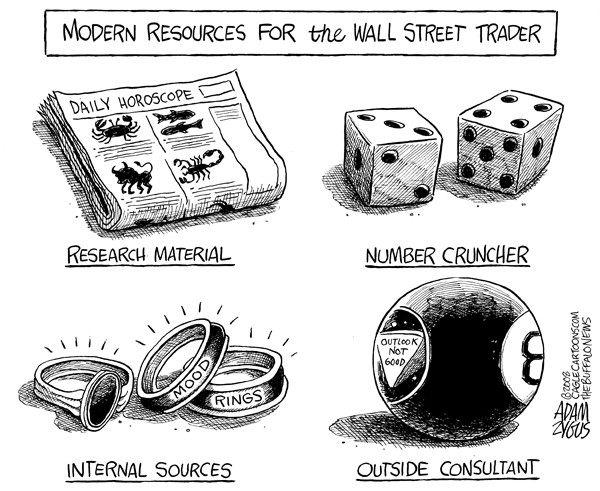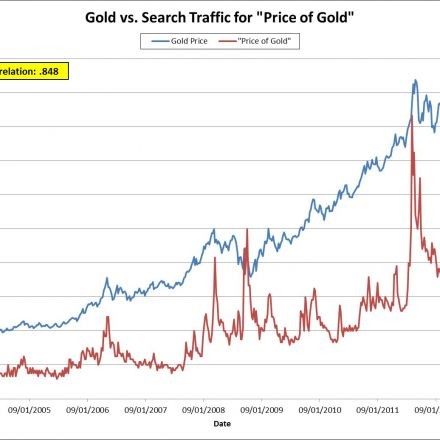Predicting Stock Market Movements
Post on: 13 Июль, 2015 No Comment

- Page Title:
- Page URL:
This page has been successfully added into your Bookmark.
1 followers
Follow
I’ve been thinking about starting a stock market prediction business. Clearly, there is a huge market for timely and accurate information of this type, and just as clearly, predicting the future is much easier than dealing with the realities of whatever is actually happening at the moment. If investors could know what’s going to happen next, they could develop a plan to deal with it in the present. Maybe Wall Street could help me get this new business up and running!
What’s that? Wall Street institutions already spend billions predicting future price movements of the stock market, individual issues & indices, commodities, and hemlines. Really? Is that right also? Economists have been analyzing and charting world economies for decades, showing clearly the repetitive cyclical changes and their upward bias. Funny then, or strange would be more accurate, that the advice generated by the oracles of Wall Street seems to assume that the current environment, good or bad, will be everlasting. Isn’t it this kind of thinking and advising that prolongs the downturns and bubbles the advances—in all markets?
If it were true that our favorite pinstriped product pushers can actually predict the future, why would investors do what they do in response to the predictions? Why would financial professionals of every shape and size holler: sell at lower prices, and buy at any price when market valuations surge upward? Shouldn’t lower prices be the call to the mall? Most Wall Street soothsaying has a short-term focus that dwells upon today’s market conditions; most Wall Street glossies emphasize the long-term nature of investment programs, and encourage investors to apply patience to the program they decide to use for goal achievement. Why is the advice so out of sinc?
The reason for the emphasis confusion is simple: it’s easier to play to the emotion of the moment than it is to look beyond— even though we all know that a directional change will be along eventually. Regardless of the direction, Wall Street advice will always fuel the operative emotion: greed or fear! Wall Street’s retail representatives never go against the grain of the consensus opinion— particularly the one projected to them by their superiors. You cannot obtain independent thinking from a Wall Street salesperson; it doesn’t fill up the Beemer.
Here’s some global advice that you will not hear on the street of dreams: Sell into rallies. Buy on bad news. Buy slowly; sell quickly. Always sell too soon. Always buy too soon. And by the way, who do you think is buying and selling the securities you have been told to dump or to hoard?
No self respecting guru would ever refute the basic truths that the market indices, individual issue prices, the economy, and interest rates will continue to move in both directions, unpredictably, forever. Hmmm, this is where you need to focus your attention if you want to get through the investment process with your sanity. You need to expect and plan for directional changes and learn to use them to your advantage. Tranquilizers may be necessary to get you through the first few cycles, but if you have minimized your risk properly, you can actually thrive on the long-term predictability of the markets.
The risk of loss cannot be eliminated. A simple change in a security’s market value is not a loss of principal just as certainly as a change in the market value of your home is not evidence of termite damage. Markets are complicated; emotions about one’s assets are even more so. Cyclical changes in all markets are just as predictable conceptually as knowing approximately where you are within a cycle is knowable actually. The key is to understand what your securities are expected to do within the cyclical framework. Now there’s a knowledge business with no Wall Street practitioners!

Predicting individual stock prices is a totally different ball game that requires a more powerful crystal ball and an array of semi legal and illegal relationships that are unavailable to most investors. There are just too many variables. Prediction is impossible, but probability assessment has enormous potential. Investing in individual issues has to be done differently, with rules, guidelines, and judgment. It has to be done unemotionally and rationally, monitored regularly, and analyzed with performance evaluation tools that are portfolio specific.
This is not nearly as difficult as it sounds, and if you are a shopper, looking for bargains elsewhere in your life, you should have no trouble understanding the workings of the stock market. There are only three decision-making scenarios that investors need to master if they want to predict long-term success for their portfolios.
The Buy decision has two important steps: Step one allocates the available investment assets, by purpose, between Equity and Income securities, based on the goals of the investment program. It is done best using The Working Capital Model. Step two establishes strict selection quality measures and diversifies properly within each security class. Investment Grade Value Stocks are the low-risk equity champions; long-term, non-gimmick, managed CEFs produce the best income/diversification mix available in readily tradeable form.
The Sell decision involves setting reasonable targets for profit taking for all securities in the portfolio. Loss taking decisions must not be undertaken out of fear, and must be avoided during severe market downturns. Understanding the forces causing market value shrinkage is important and a highly disciplined hand at the emotion control button is essential. There is no such thing as a good loss of capital.
The Hold decision is most common, and it regulates and moderates the process, keeping it less than frantic. Continue to hold onto fundamentally strong equities and income securities that are providing their normal cash flow. Hold weaker positions until the appropriate cycle (market, interest, economy) changes direction, and then consider whether to sell or to buy more.
Wall Street spins reality in whatever manner it can to make most investors unhappy, thus increasing new product sales. Your confusion, fear, greed, impatience, and need for a quick panacea fuels their profit engines, not yours. Learn how to deal unemotionally with Wall Street events and shun the herd mentality. that’ll fix ‘em.
Steve Selengut
www.sancoservices.com
www.valuestockindex.com
Professional Portfolio Management since 1979
Author of: The Brainwashing of the American Investor: The Book that Wall Street Does Not Want YOU to Read, and A Millionaire’s Secret Investment Strategy














